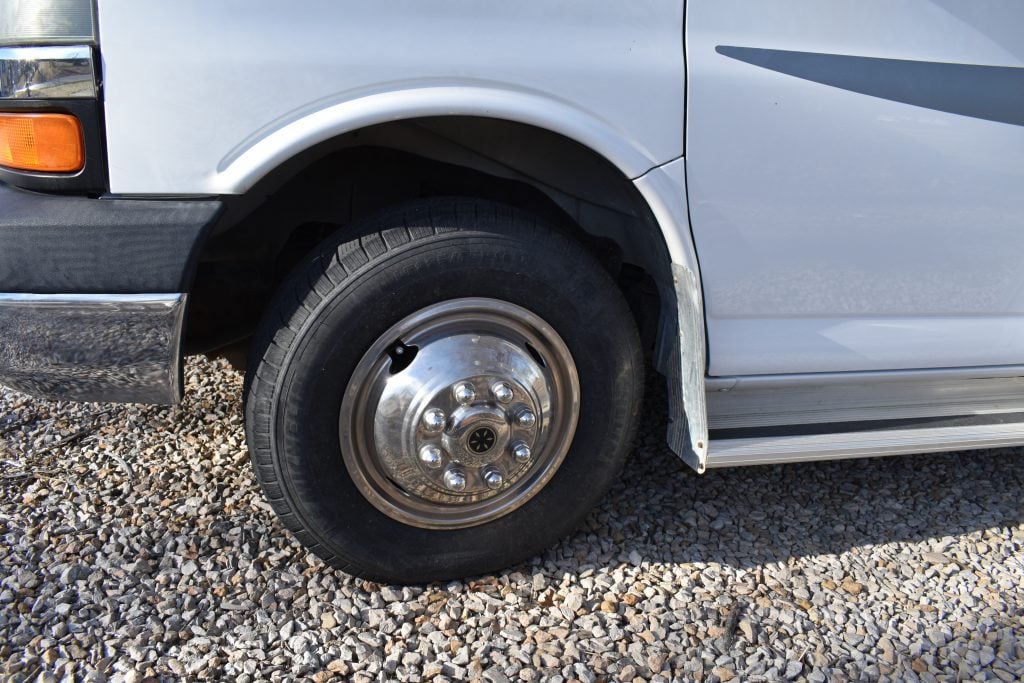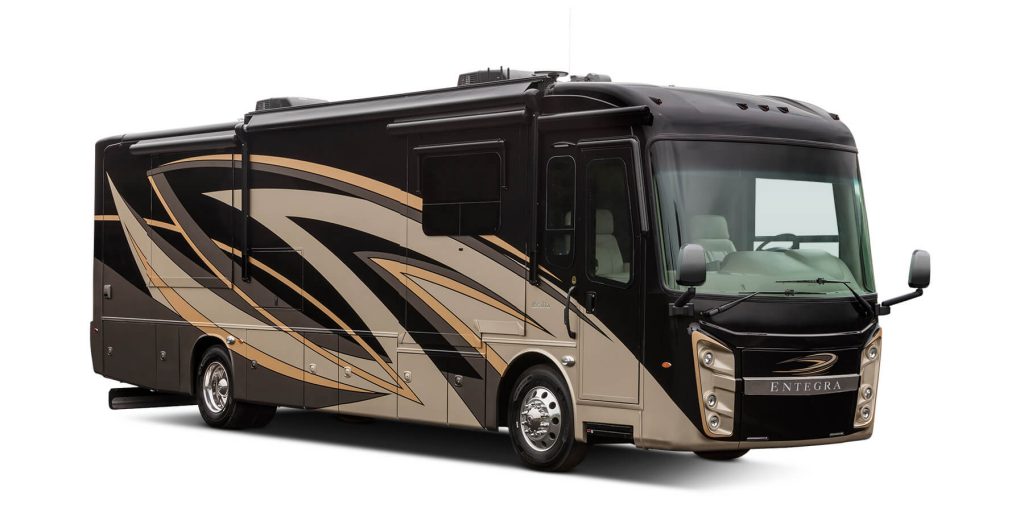
Your Safety is Riding on Maintained RV Tires
Regular monitoring and maintenance are critical to the health and condition of motorhomes. Proper care can enhance handling, improve fuel economy, prevent irregular tire wear, and extend the life of the vehicle and its components.
As a motorhome owner, it is especially important to categorize tires as a foundational element of the vehicle because when it comes to upkeep, RV tire maintenance and weighing the motorhome go hand in hand, and can save you in terms of time and long-term damage.
RV tire maintenance starts with five key areas:
- Regularly inspect your tires for damage.
- Keep your tires properly inflated to maximize performance.
- Ensure Gross Vehicle Weight doesn’t exceed the Gross Vehicle Weight Rating (GVWR).
- Ensure the load on your tires is evenly distributed.
- Have your wheel and RV tire maintenance performed regularly.

Entegra Motorhome with a Spartan Chassis – Photo: Entegra
RV tire maintenance
RV tire maintenance is a necessity and ensures the longest useful life of your investment. Not only is improper maintenance dangerous, but it can cause tire damage or failure, premature wear of the vehicle, and a harsher ride. One of the most important areas of tire upkeep is proper inflation pressure, which varies in each tire depending on the weight of the fully loaded vehicle.
Preserving the correct inflation pressure allows for full tread contact with the road surface to promote traction, capability, and handling. An underinflated or overloaded tire will build excessive heat that could go beyond the endurance of the rubber and radial cords, causing rapid tire failure and overall harm to the motorhome.
How to figure out RV tire inflation pressure
To determine the correct inflation pressure, check the sidewall of the vehicle tires to find the maximum load capacity for the tire size and load rating as well as the minimum cold air inflation needed to carry that maximum. The ratings will be listed as follows:
1. Gross Vehicle Weight Rating (GVWR)—Maximum allowable weight of the fully loaded vehicle
2. Gross Vehicle Weight (GVW)—Actual weight obtained when the fully loaded vehicle is driven onto a scale
3. Gross Axle Weight Rating (GAWR)—Maximum weight allowed across a single axel (front or rear)
4. Gross Axle Weight (GAW)—Actual weight placed on each individual axle, must never exceed GAWR
5. Unloaded Vehicle weight (UVW)—Weight of the recreational vehicle including fuel, oil, and coolants
6. Gross Combination Weight Rating (GCWR)—Maximum allowable loaded weight, including a towed vehicle
7. Gross Combined Weight (GCW)—Actual loaded weight including a towed vehicle
To ensure vehicle control, it is important the tire pressures are the same on both ends of the axle. Exceeding these weight ratings can not only cause vehicle failures but can also have legal and safety consequences. Additionally, special licensing may be required depending on the state in which the vehicle is registered.
Weighing your motorhome
To weigh a motorhome and ensure accurate air inflation is reported, the vehicle must be fully loaded. This includes everything from fuel, water tanks, propane, passengers, food, and supplies, as well as any towed vehicle, such as a trailer, boat, or car.
If the motorhome is towing a vehicle, the GCWR – total actual loaded weight of the motorhome and total actual loaded weight of the towed vehicle – must be calculated for accurate weight representation.

It is recommended to weigh each wheel position of the motorhome individually to verify proper pressure. If all wheel positions are not measured, one position risks substantial overload.
Are you carrying an even RV load?
A precise, even load can help enhance handling of the vehicle, improve fuel economy, prevent irregular tire wear and extend the life of tires, maintain braking ability, extend the life of suspension components, and protect vehicle or trailer components from excessive attrition.
The only way to get a clear indication of how the weight of the motorhome is distributed is to weigh the motorhomes at each wheel position of the vehicle. Weight can be calculated with the following scales:
- Platform—Usually long enough to weigh the entire vehicle at once
- Segmented Platform—Segmented sections provide both individual and total vehicle weight at once
- Single Axle—Weighs one axle at a time
Once the weight of the motorhome is confirmed, it is critical to evaluate the data. For optimal control over the motorhome, the tire pressure should be the same across the axle.
Check RV tire load and inflation numbers
From here, a load and inflation table will support by indicating the tire pressure necessary, but keep in mind the inflation pressure should never exceed the maximum inflation rating indicated on the wheel of the motorhome.
So, how often should tire pressure be checked, and when? How does one check the inflation pressure of their tires? Is there an RV tire maintenance schedule recommendation? At minimum, check inflation pressure on all tires on a weekly basis. Do it before a long-distance trip. Additionally, check tires at the start of every season.
Be sure to keep temperature and atmospheric pressure in mind since both effect tire inflation pressure. Check RV tire pressure when the tires are cold. The pressure in a hot tire can be as much as 10 to 25 psi higher than cold tire pressure. Check tire pressure in the early morning, before hitting the road.
Additional RV tire maintenance considerations
Preserving motorhome or camper tires does not end here. Proper cleaning is also imperative in extending the life of the tires, as accumulation of debris is damaging. Dirty, oily road surfaces will cause deterioration and premature tire aging. To eliminate this issue, be sure to wash tires with a soft brush, mild soap, and water for optimal results.
Avoid tire cleaning products with petroleum distillates, alcohol, and silicone. They can cause sidewall cracking.

This tire is showing uneven tread wear.
Thorough tire inspection is also vital and includes checking for bad or uneven tread wear, cracks, cuts, and feathering. To combat these potential issues, periodically measure wear through tread depth measurements, which helps identify if there is enough traction for the motorhome to grip the road.
Take the measurement across the tread and around the tire circumference. For rear tires, you need 2/32” tread depth in every adjacent grove. The front tires require 4/32” in every adjacent grove. Is the tread greater than 2/32”? An RV tire maintenance inspection professional should inspect them.
Inspect RV tire sidewalls
In addition to checking tread, be sure to inspect tire sidewalls for signs of aging, such as cracks. Consider how much you drive and age of the tires. Know the correct storage techniques if you don’t drive your RV very often. Storing the motorhome in a cool, dry place, carefully cleaning the tires before storing and inflating tires to maximum inflation pressure are important.
If possible, also consider covering your tires before storing. Most manufacturers recommend replacing tires every 10 years, some as early as six years, as older tires have an increased risk for weather checking and other complications.
Remember, tires are an essential component of the motorhome and call for time and attention from the vehicle owner. We want you to protect your investment! Following these tips to safeguard your vehicle will lead to an overall satisfactory experience and extended lifespan of your motorhome. Visit Spartan RV Chassis for additional information.
Track your RV maintenance
Make sure you keep track of all your RV maintenance and repairs with an online tool such as RV LIFE Maintenance. Not only can you keep all of your documents in one place, but you’ll also receive timely reminders when maintenance is due to help you avoid costly repairs and potentially serious accidents.
Mike O’Neil started at Spartan RV Chassis—part of The Shyft Group family of brands and formerly known as Spartan Motors—in 1991, working on everything from production of motor homes, fire trucks and bus chassis to quality control and customer service. He served as a technical trainer at Cummins Michigan from 1999-2001 but returned to Spartan in 2001 as a technical trainer for the Spartan Training Academy, a comprehensive training program that gives RV owner’s the ins and outs of coach driving, maintenance, and service needs. The curriculum stands apart from all other RV training programs, as it includes instruction from award-winning certified technicians/trainers, extensive maintenance instruction, driver training, and review of the chassis sub-systems such as electrical and air suspension.
In addition to training coach owners for more than 25 years now, Mike has also trained thousands of motor home and fire truck technicians. He is often representing Spartan RV Chassis at major events and rallies to present seminars for OEM and industry support.

The uneven tire wear in the picture isn’t a cause of poor maintenance but it could be a result of it